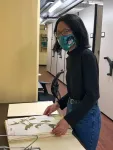How math can help us understand the human body
Graph theory helps biologists study homeostasis, researchers say
2021-03-03
(Press-News.org) Healthy human bodies are good at regulating: Our temperatures remain around 98.6 degrees Fahrenheit, no matter how hot or cold the temperature around us. The sugar levels in our blood remain fairly constant, even when we down a glass of juice. We keep the right amount of calcium in our bones and out of the rest of our bodies.
We couldn't survive without that regulation, called homeostasis. And when the systems break down, the results can cause illness or, sometimes, death.
In presentations at the American Association for the Advancement of Science's annual meeting, researchers argued that mathematics can help explain and predict those breakdowns, potentially offering new ways of treating the systems to prevent or fix them when things go wrong. The meeting was held virtually earlier this year because of the COVID-19 pandemic.
Homeostasis "is a biological phenomenon and biological systems wouldn't work without it," said Marty Golubitsky, one of the presenters and a distinguished professor of natural and mathematical sciences at The Ohio State University. "And if you had detailed, accurate mathematical models, you could numerically explore those systems, find places where this control really happens, and then you could estimate how things go wrong and how you might be able to correct it."
Scientists have a good handle on the biological reasons why that regulation happens: Certain systems in our bodies have to remain constant in order to function and keep our bodies alive. The math behind it, though, is less certain.
But understanding homeostasis - including predicting changes to it and calculating ways to keep the body regulated despite breakdowns in the body's systems that manage those regulations - could be a way to provide targeted medical care to people who need it, said Janet Best, co-author of some of the research behind the presentations and professor of mathematics at Ohio State.
"This is part of precision medicine," said Best, who is also co-director of Ohio State's Mathematical Biosciences Institute. "People are different, and you need a model that can work on different people. And we think that's what we've developed here."
Researchers at the MBI and at other institutions who study how math and biology intersect have built models to explain how the body maintains homeostasis in a variety of systems. At the heart of those models is a graph, a mathematical concept that seeks to explain how objects relate to one another. (If you took algebra or geometry in high school, you likely learned some of the basics of graph theory.)
Golubitsky and Best said that graph theory can help explain and predict changes to homeostasis in the body. That explanation, they say, could be useful for biologists and others looking for ways to intervene when homeostasis breaks down. That breakdown causes a number of problems - too much glucose in a person's blood, for example, or not enough calcium in their bones.
The AAAS presentations focused both on a graph that models how the body regulates dopamine levels through homeostasis and how graph theory helps identify properties of graphs that can help predict homeostasis. Golubitsky and Best described how dopamine and the enzymes that break it down can be represented as a mathematical formula associated with a graph.
They showed that, by calculating changes in the nodes, it might be possible to calculate or predict changes in dopamine levels. That approach could be expanded to other systems, Golubitsky said, though future study is needed to know for sure. That study is already underway, he said.
"Homeostasis is an important enough area in biology that if mathematics can contribute anything, it's a success," he said.
INFORMATION:
CONTACTS: Marty Golubitsky, golubitsky.4@osu.edu
Janet Best, best.82@osu.edu
Written by Laura Arenschield, arenschield.2@osu.edu
ELSE PRESS RELEASES FROM THIS DATE:
2021-03-03
Imagine seeing the world in muted shades -- gray sky, gray grass. Some people with color blindness see everything this way, though most can't see specific colors. Tinted glasses can help, but they can't be used to correct blurry vision. And dyed contact lenses currently in development for the condition are potentially harmful and unstable. Now, in ACS Nano, researchers report infusing contact lenses with gold nanoparticles to create a safer way to see colors.
Some daily activities, such as determining if a banana is ripe, selecting matching clothes or stopping at a red light, can be difficult for those ...
2021-03-03
Land stores vast amounts of carbon, but a new study led by Cranfield University's Dr Alice Johnston suggests that how much of this carbon enters the atmosphere as temperatures rise depends on how far that land sits from the equator.
Ecosystems on land are made up of plants, soils, animals, and microbes - all growing, reproducing, dying, and breathing in a common currency; carbon. And how much of that carbon is breathed out (also known as ecosystem respiration) compared to how much is stored (through primary production) has impacts for climate change. ...
2021-03-03
Using the model organism Caenorhabditis elegans, researchers at the University of Cologne have developed an 'aging clock' that reads the biological age of an organism directly from its gene expression, the transcriptome. Bioinformatician David Meyer and geneticist Professor Dr Björn Schumacher, director of the Institute for Genome Stability in Aging and Disease at the CECAD Cluster of Excellence in Aging Research and the Center for Molecular Medicine Cologne (CMMC), describe their so-called BiT age (binarized transcriptomic aging clock) in the article 'BiT age: A transcriptome based aging clock near the theoretical limit of accuracy' in Aging Cell.
We are all familiar ...
2021-03-03
Alexandria, Va., USA -- The clinical picture of COVID-19 in various target organs has been extensively studied and described, but relatively little is known about the characteristics of oral cavity involvement. The study "Frequent and Persistent Salivary Gland Ectasia and Oral Disease After COVID-19" published in the Journal of Dental Research (JDR), investigated the presence and prevalence of oral manifestations in COVID-19 survivors.
Researchers at the Università Vita Salute San Raffaele, Milan, Italy, profiled the oral involvement in 122 COVID-19 survivors, hospitalized and followed up at a single referral visit after a median 104 days from ...
2021-03-03
Systemic fungal infections are much rarer than other illnesses, but they are potentially deadly, with limited options for treatment. In fact, fungi are becoming increasingly resistant to the few drugs that are available, and infections are growing more common. A cover story in Chemical & Engineering News, the weekly newsmagazine of the American Chemical Society, details how scientists are working to improve our antifungal arsenal.
At present, there are only four types of antifungal drugs approved by the U.S. Food and Drug Administration (FDA), and some infections are resistant to those drugs, making surgery ...
2021-03-03
Fields are covered with dandelions in spring, a very common plant with yellow gold flowers and toothed leaves. When they wither, the flowers turn into fluffy white seed heads that, like tiny parachutes, are scattered around by the wind. Taraxacum officinale, that is its scientific name, inspired legends and poems and has been used for centuries as a natural remedy for many ailments.
Now, thanks to a study conducted at the University of Trento, dandelions will inspire new engineered materials. The air trapping capacity of dandelion clocks submerged in water has been measured in the lab for the first time. The discovery paves the way for the development of new and advanced ...
2021-03-03
CLEMSON, South Carolina - Clemson University scientists have linked climatic fluctuations over the past one and a quarter-century with flower color changes.
Researchers combined descriptions of flower color from museum flower specimens dating back to 1895 with longitudinal- and latitudinal-specific climate data to link changes in temperature and aridity with color change in the human-visible spectrum (white to purple).
The study, which was published in the journal Proceedings of the Royal Society B, showed the change varied across taxa.
"Species ...
2021-03-03
PROVIDENCE, R.I. [Brown University] -- Humans have made a remarkable impact on the planet, from clearing forests for agriculture and urbanization to altering the chemistry of the atmosphere with fossil fuels. Now, a new study in the journal Nature reveals for the first time the extent of human impact on the global water cycle.
The study used NASA's Ice, Cloud and Land Elevation Satellite (ICESat-2) to assemble the largest ever dataset of seasonal water levels in more than 227,000 lakes, ponds and reservoirs worldwide. The data reveal that even though human-managed reservoirs comprise only a small percentage of all water bodies, they account for 57% of the total seasonal water storage changes globally.
"We ...
2021-03-03
A team from the Chinese Academy of Sciences and Cardiff University say they have found the strongest evidence yet of a "migration gene" in birds.
The team identified a single gene associated with migration in peregrine falcons by tracking them via satellite technology and combining this with genome sequencing.
They say their findings add further evidence to suggest genetics has a strong role to play in the distance of migration routes.
The study, published today in the journal Nature, also looks at the predicted effect of climate change on migration - and how this might interact with evolutionary factors.
The researchers tagged 56 Arctic peregrine falcons and tracked their journeys by satellite, following their annual flight distances and directions in detail.
They found the studied ...
2021-03-03
At the beginning of an immune response, a molecule known to mobilize immune cells into the bloodstream, where they home in on infection sites, rapidly shifts position, a new study shows. Researchers say this indirectly amplifies the attack on foreign microbes or the body's own tissues.
Past studies had shown that the immune system regulates the concentration of the molecule, sphingosine 1 phosphate (S1P), in order to draw cells to the right locations. The targeted cells have proteins on their surface that are sensitive to levels of this molecule, enabling them to follow the molecule's "trail," researchers say. S1P concentration gradients, for instance, can guide immune T cells to either stay in lymph nodes, connected glands in which these cells mature, or move into blood ...
LAST 30 PRESS RELEASES:
[Press-News.org] How math can help us understand the human body
Graph theory helps biologists study homeostasis, researchers say


